-
 Bitcoin
Bitcoin $79,012.1761
-4.78% -
 Ethereum
Ethereum $1,570.4026
-12.09% -
 Tether USDt
Tether USDt $0.9994
-0.02% -
 XRP
XRP $1.9666
-7.46% -
 BNB
BNB $555.4328
-6.02% -
 USDC
USDC $0.9999
-0.01% -
 Solana
Solana $107.5201
-9.67% -
 Dogecoin
Dogecoin $0.1506
-10.27% -
 TRON
TRON $0.2315
-2.62% -
 Cardano
Cardano $0.5814
-10.27% -
 UNUS SED LEO
UNUS SED LEO $8.8602
-2.17% -
 Chainlink
Chainlink $11.3795
-10.04% -
 Toncoin
Toncoin $3.0063
-7.92% -
 Stellar
Stellar $0.2370
-5.38% -
 Avalanche
Avalanche $16.1395
-9.48% -
 Shiba Inu
Shiba Inu $0.0...01134
-7.55% -
 Sui
Sui $1.9135
-13.06% -
 Hedera
Hedera $0.1425
-11.59% -
 Polkadot
Polkadot $3.7145
-5.76% -
 MANTRA
MANTRA $5.9824
-4.31% -
 Bitcoin Cash
Bitcoin Cash $272.1059
-9.40% -
 Litecoin
Litecoin $71.2279
-13.11% -
 Dai
Dai $1.0000
-0.02% -
 Ethena USDe
Ethena USDe $0.9987
-0.05% -
 Bitget Token
Bitget Token $4.1866
-5.67% -
 Pi
Pi $0.5915
4.23% -
 Monero
Monero $200.3568
-5.71% -
 Hyperliquid
Hyperliquid $10.5427
-10.74% -
 Uniswap
Uniswap $5.1188
-11.73% -
 OKB
OKB $50.3711
-2.37%
What is the globalization trend of the NFT market?
The NFT market's globalization is driven by tech advancements, cross-industry integration, and growing cultural acceptance, reshaping the digital economy.
Apr 05, 2025 at 12:42 am
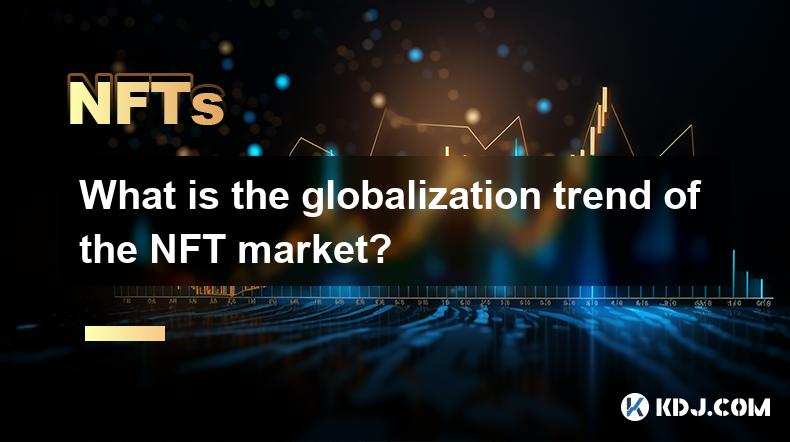
The globalization trend of the NFT market represents a fascinating evolution in the digital economy, reflecting broader shifts in technology, culture, and finance. Non-fungible tokens (NFTs) have surged in popularity, transforming from niche collectibles to a global phenomenon. This trend is driven by increased accessibility, cross-cultural appeal, and the integration of NFTs into various industries. As the market expands, it encounters challenges and opportunities alike, influencing how NFTs are perceived and utilized worldwide. Understanding this globalization trend requires examining several key areas, including market growth, regional dynamics, and the role of technology and regulation.
Market Growth and Expansion
The NFT market has experienced exponential growth over the past few years. From a modest beginning, the market's value has skyrocketed, driven by high-profile sales and celebrity endorsements. In 2021 alone, the global NFT market was valued at over $2 billion, a significant leap from previous years. This growth is not confined to a single region but is a global phenomenon, with markets in North America, Europe, and Asia all contributing to the surge. The expansion of the market is facilitated by the increasing number of platforms that support NFT creation and trading, making it easier for artists and collectors from around the world to participate.
Regional Dynamics
The NFT market's globalization is evident in its regional dynamics. In North America, particularly the United States, the market has been driven by tech-savvy investors and a vibrant art scene. Europe has seen significant growth, with countries like the UK and France emerging as key players. In Asia, markets like South Korea and Japan have shown strong interest, driven by a tech-forward culture and a passion for digital collectibles. Each region brings its unique flavor to the NFT market, influenced by local culture, regulatory environments, and technological infrastructure. This diversity contributes to the global appeal and resilience of the NFT market.
Technology and Accessibility
Technology plays a crucial role in the globalization of the NFT market. Blockchain technology, which underpins NFTs, ensures the authenticity and ownership of digital assets, fostering trust among users globally. The rise of user-friendly platforms like OpenSea, Rarible, and Foundation has democratized access to the NFT market, allowing individuals from diverse backgrounds to engage. These platforms support multiple languages and payment methods, further enhancing global accessibility. Additionally, the integration of NFTs with other technologies, such as virtual reality and augmented reality, is expanding the ways in which NFTs can be experienced and utilized, driving further global adoption.
Cultural and Industry Integration
The globalization of the NFT market is also fueled by its integration into various cultural and industry sectors. In the art world, NFTs have revolutionized how digital art is created, sold, and appreciated, with artists from around the globe participating in this new economy. The music industry has seen musicians release NFTs as a new form of fan engagement and revenue generation. In gaming, NFTs are used to represent in-game assets that players can own and trade. This cross-industry integration not only broadens the appeal of NFTs but also introduces them to new audiences worldwide, contributing to their global spread.
Regulatory Challenges and Opportunities
As the NFT market globalizes, it faces a complex regulatory landscape. Different countries have varying approaches to regulating digital assets, which can impact the growth and operation of the NFT market. Some countries have embraced NFTs, creating favorable environments for their development, while others have imposed restrictions that can hinder growth. Navigating these regulatory challenges requires collaboration between market participants and policymakers to ensure that the NFT market can continue to expand globally. At the same time, these challenges present opportunities for innovation, as the market adapts to different regulatory frameworks and finds new ways to thrive.
Impact on Traditional Markets
The globalization of the NFT market also has implications for traditional markets. As NFTs gain mainstream acceptance, they are increasingly seen as a legitimate asset class, attracting investment from traditional financial institutions. This shift is leading to the integration of NFTs into broader financial systems, with banks and investment firms exploring ways to offer NFT-related services. The impact on traditional art markets is also significant, as NFTs challenge conventional notions of ownership and value. This interplay between NFTs and traditional markets is reshaping the global economic landscape, highlighting the transformative potential of NFTs.
Future Trends and Predictions
Looking ahead, the globalization of the NFT market is likely to continue, driven by ongoing technological advancements and increasing cultural acceptance. One trend to watch is the further integration of NFTs into the metaverse, where they will play a central role in virtual economies. Another trend is the rise of decentralized finance (DeFi) platforms that incorporate NFTs, offering new ways to finance and trade digital assets. As the market matures, we can expect to see more standardized practices and possibly even global regulatory frameworks that support the continued growth and globalization of NFTs.
The Role of Education and Awareness
Education and awareness are critical to the ongoing globalization of the NFT market. As more people learn about the potential of NFTs, the market will continue to grow and diversify. Educational initiatives, such as online courses, workshops, and community events, play a vital role in demystifying NFTs and encouraging broader participation. Additionally, media coverage and celebrity endorsements help to raise awareness and drive interest in NFTs. As awareness spreads, so too does the global reach of the NFT market, bringing in new participants and fostering a more inclusive and dynamic ecosystem.
Environmental Considerations
The environmental impact of NFTs is a growing concern as the market globalizes. The energy consumption associated with blockchain networks, particularly those using proof-of-work consensus mechanisms, has sparked debate about the sustainability of NFTs. Efforts are underway to address these concerns, with some platforms transitioning to more energy-efficient consensus mechanisms like proof-of-stake. Additionally, there is a push for greater transparency around the environmental footprint of NFTs, helping consumers make informed decisions. As the NFT market continues to expand globally, addressing these environmental considerations will be crucial to its long-term viability and acceptance.
Social and Community Aspects
The globalization of the NFT market is also influenced by social and community aspects. Online communities play a significant role in driving the adoption and growth of NFTs, with platforms like Discord and Twitter serving as hubs for discussion and collaboration. These communities foster a sense of belonging and shared purpose, attracting diverse participants from around the world. The rise of NFT-based social tokens and DAOs (decentralized autonomous organizations) further enhances the social dimension of the market, enabling new forms of community governance and participation. As these social and community aspects evolve, they contribute to the global appeal and sustainability of the NFT market.
Economic Implications
The economic implications of the NFT market's globalization are far-reaching. As NFTs gain traction in various sectors, they contribute to the growth of the digital economy, creating new job opportunities and revenue streams. The market's expansion also has macroeconomic effects, influencing investment patterns and financial markets. For example, the rise of NFTs has led to increased demand for cryptocurrencies, as they are often used to purchase NFTs. This interconnectedness highlights the broader economic impact of the NFT market's globalization, underscoring its significance as a driver of economic innovation and growth.
Technological Innovations
Technological innovations continue to propel the globalization of the NFT market. Advances in blockchain technology, such as the development of layer-2 solutions and interoperability protocols, are enhancing the efficiency and scalability of NFT platforms. These innovations make it easier for users worldwide to engage with NFTs, supporting the market's global expansion. Additionally, the integration of NFTs with emerging technologies like AI and machine learning is opening up new possibilities for personalization and automation within the market. As these technological innovations progress, they will play a crucial role in shaping the future of the global NFT market.
Cultural Shifts and Acceptance
The globalization of the NFT market is also driven by cultural shifts and increasing acceptance. As more people become familiar with NFTs, cultural attitudes towards digital ownership and value are evolving. This shift is particularly pronounced among younger generations, who are more likely to embrace digital assets and new forms of creativity. The growing acceptance of NFTs in mainstream culture is evidenced by their appearance in popular media, fashion, and entertainment. As cultural acceptance grows, so too does the global reach of the NFT market, paving the way for further integration and innovation.
Global Collaboration and Partnerships
Global collaboration and partnerships are essential to the continued globalization of the NFT market. As the market expands, collaborations between artists, platforms, and institutions from different regions are fostering a more interconnected and dynamic ecosystem. These partnerships facilitate the exchange of ideas and resources, driving innovation and growth. For example, collaborations between NFT platforms and traditional art institutions are helping to bridge the gap between the digital and physical art worlds, enhancing the global appeal of NFTs. As these collaborations continue to develop, they will play a key role in shaping the future of the global NFT market.
Challenges and Opportunities in Emerging Markets
Emerging markets present both challenges and opportunities for the globalization of the NFT market. In regions with less developed financial infrastructure, accessing and participating in the NFT market can be challenging. However, these markets also offer significant growth potential, as increased internet penetration and smartphone adoption drive digital engagement. Efforts to educate and empower users in these markets, such as through localized platforms and community initiatives, are crucial to unlocking this potential. As the NFT market continues to globalize, addressing the unique challenges and opportunities in emerging markets will be essential to its long-term success.
The Role of Cryptocurrencies
Cryptocurrencies play a vital role in the globalization of the NFT market. As the primary means of purchasing NFTs, cryptocurrencies facilitate cross-border transactions and enable global participation. The increasing adoption of cryptocurrencies worldwide is thus closely linked to the growth of the NFT market. Platforms that support multiple cryptocurrencies enhance accessibility, allowing users from different regions to engage with NFTs using their preferred digital assets. As the cryptocurrency ecosystem evolves, with new tokens and payment solutions emerging, it will continue to support the globalization of the NFT market.
FAQs
Q: What drives the globalization of the NFT market?
A: The globalization of the NFT market is driven by several factors, including increased accessibility through user-friendly platforms, cross-cultural appeal, integration into various industries, and technological advancements. The growth of the market is also facilitated by global interest in digital assets and the rise of cryptocurrencies.
Q: How do regional dynamics influence the NFT market?
A: Regional dynamics significantly influence the NFT market, with different regions contributing unique cultural, technological, and regulatory elements. North America, Europe, and Asia each have distinct market characteristics, driven by local culture, investment patterns, and regulatory environments. This diversity enhances the global appeal and resilience of the NFT market.
Q: What role does technology play in the globalization of NFTs?
A: Technology is crucial to the globalization of NFTs, with blockchain ensuring the authenticity and ownership of digital assets. User-friendly platforms and the integration of NFTs with technologies like VR and AR enhance global accessibility and engagement. Ongoing technological innovations continue to drive the market's expansion.
Q: How are NFTs integrated into different industries?
A: NFTs are integrated into various industries, including art, music, and gaming. In art, they revolutionize digital ownership; in music, they offer new forms of fan engagement; and in gaming, they represent tradable in-game assets. This cross-industry integration broadens the appeal of NFTs and introduces them to new global audiences.
Q: What regulatory challenges does the NFT market face?
A: The NFT market faces a complex regulatory landscape, with different countries having varying approaches to digital assets. Navigating these challenges requires collaboration between market participants and policymakers to ensure continued growth. These challenges also present opportunities for innovation as the market adapts to different regulatory frameworks.
Q: How do NFTs impact traditional markets?
A: NFTs impact traditional markets by challenging conventional notions of ownership and value. As they gain mainstream acceptance, NFTs are increasingly seen as a legitimate asset class, attracting investment from traditional financial institutions. This integration reshapes the global economic landscape, highlighting the transformative potential of NFTs.
Q: What are the future trends in the NFT market?
A: Future trends in the NFT market include further integration into the metaverse, the rise of DeFi platforms incorporating NFTs, and the development of more standardized practices. As the market matures, global regulatory frameworks may also emerge to support its continued growth and globalization.
Q: How important is education and awareness for the NFT market?
A: Education and awareness are crucial for the ongoing globalization of the NFT market. Educational initiatives help demystify NFTs and encourage broader participation. Media coverage and celebrity endorsements also raise awareness and drive interest, contributing to the market's global reach.
Q: What are the environmental considerations of the NFT market?
A: The environmental impact of NFTs, particularly the energy consumption of blockchain networks, is a growing concern. Efforts to address these issues include transitioning to more energy-efficient consensus mechanisms and increasing transparency around the environmental footprint of NFTs. Addressing these considerations is crucial for the market's long-term viability.
Q: How do social and community aspects influence the NFT market?
A: Social and community aspects significantly influence the NFT market, with online communities driving adoption and growth. Platforms like Discord and Twitter serve as hubs for discussion and collaboration, fostering a sense of belonging. NFT-based social tokens and DAOs enhance the social dimension, enabling new forms of community governance and participation.
Q: What are the economic implications of the NFT market's globalization?
A: The globalization of the NFT market has far-reaching economic implications, contributing to the growth of the digital economy and creating new job opportunities and revenue streams. The market's expansion also influences investment patterns and financial markets, highlighting its role as a driver of economic innovation and growth.
Q: How do technological innovations support the globalization of NFTs?
A: Technological innovations, such as advances in blockchain technology and the integration of NFTs with AI and machine learning, support the globalization of NFTs by enhancing efficiency, scalability, and personalization. These innovations make it easier for users worldwide to engage with NFTs, driving the market's global expansion.
Q: How do cultural shifts impact the NFT market?
A: Cultural shifts and increasing acceptance of digital ownership and value drive the globalization of the NFT market. Younger generations are more likely to embrace NFTs, and their growing acceptance in mainstream culture further enhances the market's global reach. As cultural attitudes evolve, so too does the market's integration and innovation.
Q: What role do global collaborations and partnerships play in the NFT market?
A: Global collaborations and partnerships are essential to the globalization of the NFT market, fostering a more interconnected and dynamic ecosystem. Collaborations between artists, platforms, and institutions from different regions facilitate the exchange of ideas and resources, driving innovation and growth. These partnerships enhance the global appeal of NFTs.
Q: What challenges and opportunities do emerging markets present for the NFT market?
A: Emerging markets present challenges such as limited financial infrastructure but also significant growth potential due to increasing digital engagement. Efforts to educate and empower users in these markets through localized platforms and community initiatives are crucial to unlocking this potential. Addressing these challenges and opportunities is essential for the market's long-term success.
Q: How do cryptocurrencies facilitate the globalization of the NFT market?
A: Cryptocurrencies facilitate the globalization of the NFT market by enabling cross-border transactions and global participation. As the primary means of purchasing NFTs, the increasing adoption of cryptocurrencies worldwide supports the growth of the NFT market. Platforms that support multiple cryptocurrencies enhance accessibility, allowing users from different regions to engage with NFTs.
Disclaimer:info@kdj.com
The information provided is not trading advice. kdj.com does not assume any responsibility for any investments made based on the information provided in this article. Cryptocurrencies are highly volatile and it is highly recommended that you invest with caution after thorough research!
If you believe that the content used on this website infringes your copyright, please contact us immediately (info@kdj.com) and we will delete it promptly.
- Pepe (PEPE) Weekly Performance Hints At Huge Surge
- 2025-04-07 04:15:13
- XRP Price Tanks 12.8% This Week — More Pain to Come?
- 2025-04-07 04:15:13
- XRP's Funding Rate Has Dropped to Negative 0.012%, a Level Last Seen When the Asset Traded Near $0.33
- 2025-04-07 04:10:13
- A major supply event is coming for the SUI token
- 2025-04-07 04:10:13
- Memecoin DEX PumpSwap Makes a Significant Impact, Attracting 700K Wallets and Facilitating 30M Swaps
- 2025-04-07 04:05:12
- Ronin Network (RON) Has Retraced Heavily This Year
- 2025-04-07 04:05:12
Related knowledge
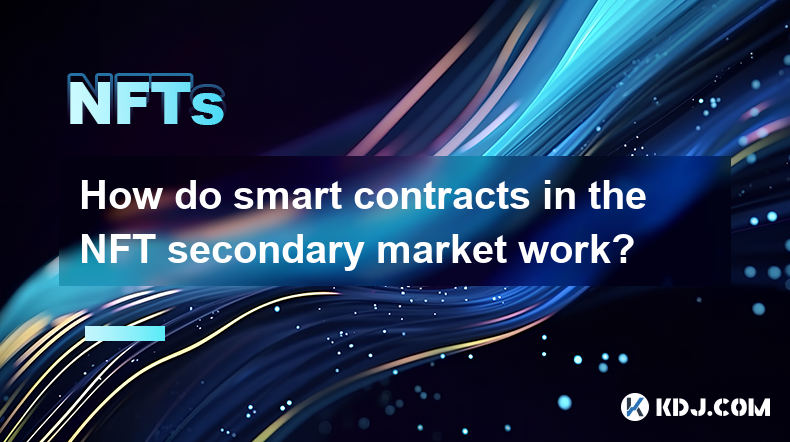
How do smart contracts in the NFT secondary market work?
Apr 03,2025 at 07:14am
Smart contracts play a pivotal role in the NFT secondary market, facilitating seamless transactions and enforcing predefined rules. These self-executing contracts with the terms of the agreement directly written into code are stored on the blockchain. In the context of NFTs, smart contracts automate the buying, selling, and transferring of digital asset...
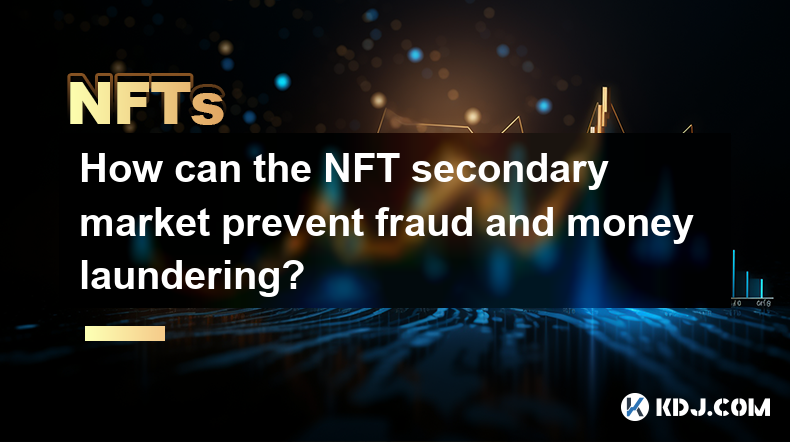
How can the NFT secondary market prevent fraud and money laundering?
Apr 03,2025 at 08:35am
The NFT secondary market has become a thriving hub for digital art and collectibles, but it also faces challenges in preventing fraud and money laundering. To tackle these issues, the market can implement various strategies and technologies to ensure a safer and more transparent trading environment. This article will explore how the NFT secondary market...

How are transaction fees in the NFT secondary market calculated?
Apr 04,2025 at 05:28am
The calculation of transaction fees in the NFT secondary market is a crucial aspect that both buyers and sellers need to understand. These fees can significantly impact the overall cost of transactions and the profits that sellers can make. In this article, we will delve into the various components that make up these fees, how they are calculated, and w...
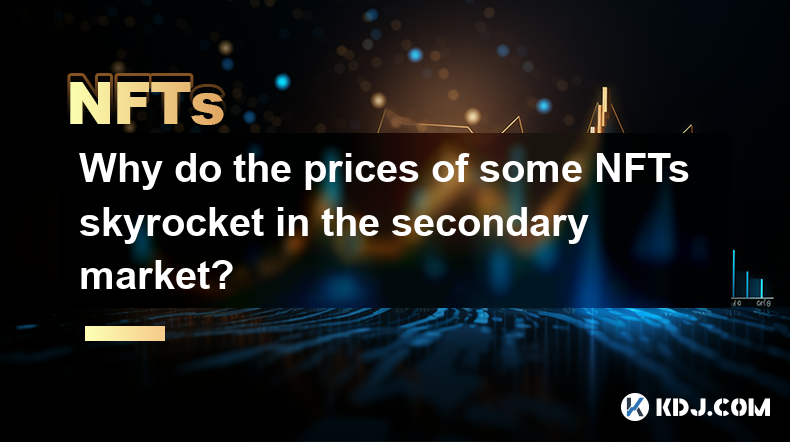
Why do the prices of some NFTs skyrocket in the secondary market?
Apr 06,2025 at 07:08am
The phenomenon of NFT prices skyrocketing in the secondary market is a fascinating aspect of the cryptocurrency and digital art world. Non-Fungible Tokens (NFTs) have taken the digital world by storm, and their value can surge dramatically after initial sales. Several factors contribute to this price surge, including rarity, demand, speculation, and the...
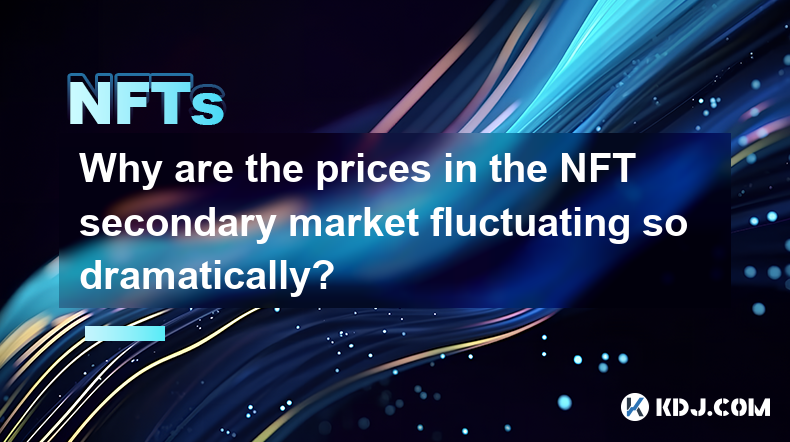
Why are the prices in the NFT secondary market fluctuating so dramatically?
Apr 03,2025 at 10:35pm
The NFT secondary market has been experiencing dramatic price fluctuations, leaving many in the cryptocurrency community puzzled and curious. To understand this phenomenon, it's essential to delve into the factors driving these price movements. From the impact of market sentiment and celebrity endorsements to the role of speculation and the unique natur...
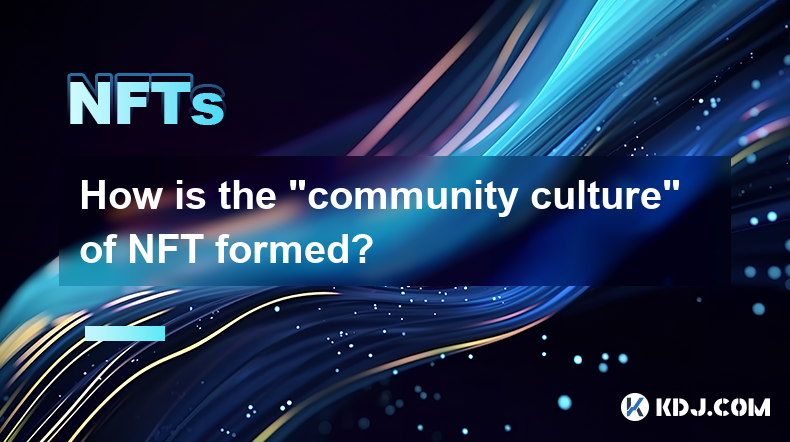
How is the “community culture” of NFT formed?
Apr 03,2025 at 11:07am
The formation of the 'community culture' within the NFT (Non-Fungible Token) space is a fascinating and multi-faceted process. It involves various elements such as shared interests, active engagement, and the creation of a sense of belonging among members. NFT communities often revolve around specific projects or artists, fostering a unique environment ...

How do smart contracts in the NFT secondary market work?
Apr 03,2025 at 07:14am
Smart contracts play a pivotal role in the NFT secondary market, facilitating seamless transactions and enforcing predefined rules. These self-executing contracts with the terms of the agreement directly written into code are stored on the blockchain. In the context of NFTs, smart contracts automate the buying, selling, and transferring of digital asset...

How can the NFT secondary market prevent fraud and money laundering?
Apr 03,2025 at 08:35am
The NFT secondary market has become a thriving hub for digital art and collectibles, but it also faces challenges in preventing fraud and money laundering. To tackle these issues, the market can implement various strategies and technologies to ensure a safer and more transparent trading environment. This article will explore how the NFT secondary market...

How are transaction fees in the NFT secondary market calculated?
Apr 04,2025 at 05:28am
The calculation of transaction fees in the NFT secondary market is a crucial aspect that both buyers and sellers need to understand. These fees can significantly impact the overall cost of transactions and the profits that sellers can make. In this article, we will delve into the various components that make up these fees, how they are calculated, and w...

Why do the prices of some NFTs skyrocket in the secondary market?
Apr 06,2025 at 07:08am
The phenomenon of NFT prices skyrocketing in the secondary market is a fascinating aspect of the cryptocurrency and digital art world. Non-Fungible Tokens (NFTs) have taken the digital world by storm, and their value can surge dramatically after initial sales. Several factors contribute to this price surge, including rarity, demand, speculation, and the...

Why are the prices in the NFT secondary market fluctuating so dramatically?
Apr 03,2025 at 10:35pm
The NFT secondary market has been experiencing dramatic price fluctuations, leaving many in the cryptocurrency community puzzled and curious. To understand this phenomenon, it's essential to delve into the factors driving these price movements. From the impact of market sentiment and celebrity endorsements to the role of speculation and the unique natur...

How is the “community culture” of NFT formed?
Apr 03,2025 at 11:07am
The formation of the 'community culture' within the NFT (Non-Fungible Token) space is a fascinating and multi-faceted process. It involves various elements such as shared interests, active engagement, and the creation of a sense of belonging among members. NFT communities often revolve around specific projects or artists, fostering a unique environment ...
See all articles





















































































